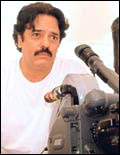Home > Movies > Interviews
'I wanted Ash as Mumtaz Mahal'
February 18, 2003 15:47 IST
Jodhpur's Mehrangarh Fort, home to the Rajput rulers of the kingdom of Marwar, is bustling.
The 15th century fort is leased out to filmmaker Akbar Khan for his Taj Mahal -- An Eternal Love Story, an opulent take on Emp eror Shah Jahan's love for his wife Mumtaz Mahal.
eror Shah Jahan's love for his wife Mumtaz Mahal.
The interiors of the real Taj Mahal -- with emerald and sapphire encrusted walls and gold and silver doors, apart from the interiors of the Diwan-e-Khaas and Agra Fort --have been recreated at Mehrangarh.
"Taj Mahal is designed for the Indian and international markets," says Akbar Khan, younger brother of actor-director brothers Feroz and Sanjay Khan. The film starts with an ageing Shah Jahan reminiscing about his first meeting with Anjuman Bano, later Mumtaz Mahal.
Excerpts from an interview with Vickey Lalwani:
Your last film was Haadsa in 1983. What made you return to filmmaking after two decades?
I acted in films like Aakarshan and Swati as leading man. Then I started making a feature film. I had completed 50 per cent of it when unfortunately my brother Sanjay met with an accident on the sets of his television serial The Sword Of Tipu Sultan. I then helped him complete the serial. I made about 20 episodes which took 18 months.
Did your stint with The Sword Of Tipu Sultan draw you towards television?
In a way, yes. In those days, television serials were a new thing. It was good I switched over. The Sword Of Tipu Sultan taught serialmakers to make serials cinematically. Then I made Akbar -- The Great, the most expensive serial. That taught serialmakers how to make a serial on a grand canvas.
What attracted you towards this story?
This subject has been playing on my mind ever since I started making Akbar -- The Great. I want to make a film that will bring a glorious passage of history to life. I want to transport viewers to the times of the Peacock Throne and to experience a romance that turned into an eternal love story.
The script has been co-written by South African freedom fighter Fatima Meer...
Yes. I met her through a common friend in New Delhi. Fatima is one of the most respected ladies in South Africa. has a tremendous love for India and its culture. She also wrote The Making Of Mahatma, directed by Shyam Benegal.
Fatima was keen that Akbar -- The Great should be aired on the SABC [South African Broadcasting Corporation] channel. It was a successful venture. Naturally, I was pleased. I invited her to India; we had long discussions. We decided to write the film together.
In Hollywood, they spend about three years scripting and writing the screenplay, and about six months to shoot the film. In India, it is the reverse. I avoided this by doing a lot of research.
How did you do the casting?
It was not easy to finalise the cast -- this is one film where actors and actresses have to fit the characters. I needed characters larger than life -- tall, handsome, broad men and fair, delicate curvaceous women.
After a lot of thought, I opted for newcomers. I did not want people to see someone whose image was entrenched in their minds. It would make identifying the character very difficult.
The first person that came to my mind for Shah Jahan's role was Kabir Bedi. Who can be more dashing than him? A problem arose when I needed someone to play young Shah Jahan. I needed someone who resembled Kabir -- someone as tall, handsome and dynamic. I screen-tested over 100 actors and zeroed in on [model-turned-actor] Zulfiqar Syed. He came closest to Kabir.
For Mumtaz Mahal, I wanted Aishwarya Rai. That was a time when she was not over-exposed. But she started signing many films, so I dropped the thought of casting her. I did not want the audience to say 'Paro has become Mumtaz Mahal.'
I chose Sonya Jehan [granddaughter of yesteryear singer Noorjehan] She was doing her final year in textile designing in London. One look at her and I was impressed. I called her to India for a screen test. She passed with flying colours.
Pooja Batra is very excited about playing Shah Jahan's mother Noorjehan. She was a very strong, scheming character. That she was an archer and horsewoman makes her character more interesting. My first choice for Noorjehan was Rekha. I spoke to her, but she was unable to adjust her dates as per my requirements. I did not want to run behind her.
Kim Sharma plays a pompous and witty princess Laadili Begum. The film marks Arbaaz Ali's debut as Jahangir. Arbaaz Khan portrays Aurangzeb. With a hooked nose, Arbaaz looks just like Aurangzeb.

Shah Jahan's daughter Jahan Ara, who stood by him till his death, is played by Manisha Koirala. Manisha has tried her hand at all kinds of roles. This is yet another bold character which I am sure will be appreciated.
Why did you choose Mehrangarh Fort?
Most of the shooting has been in and around Jodhpur, Rajasthan. I chose Mehrangarh Fort for its warm environment, which complements the architecture of the period and gives it authenticity. I have 16 sets there. I had the option of creating the sets in a studio, but I opted for a natural environment. It has the aura of that historical period.
When did you start shooting?
I started on February 7, 2002 and will wind up by April 20, 2003.
How much homework have you put in?
A lot! Since nine years -- right from the days of Akbar - The Great, I have been reading and understanding the aspects of costumes, architecture and artifacts. Three years ago, I put everything on paper. We made miniatures of virtually every set. In such an expensive film, you cannot afford to take a wrong step.
Did the artistes do their homework?
Yes. I put some of my artistes, especially the newcomers, under a crash course of acting, etiquette, speech and carriage. I wanted them to get into the skin of the characters.
Was it challenging recreating a bygone area?
Tremendously! The marble inlay work, furnishing and hundreds of carpets -- embellished with typical Mughal motifs --were designed individually for every set. We recreated Agra fort where Shah Jahan was kept imprisoned for seven to eight years and from where he would watch the Taj Mahal.
The costumes have been researched thoroughly by Anna Singh. We even acquired authentic pieces of artillery and weaponry for the main stars. The screenplay has carefully integrated the characters during the time of Anjuman Bano and Shah Jahan. None of the history books delve into this.
All that is known is that Mumtaz Mahal delivered a child and died. We tried to visualise their interaction.
Does the success of periodical films like Lagaan and Devdas excite you?
Yes. Period films have found great acceptance in India and abroad. Even Americans are making many historicals.
We already have a Taj Mahal in the past. Aren't you worried about comparison?
Comparisons are inevitable but unfair. People must remember that times have changed. My technique is different from the old Taj Mahal. That film had a lot of melodrama and a look of the time. If I was to make it in the same manner today, it will not be accepted. Also, unlike the old Taj Mahal, mine has a rapid screenplay.
How did you get the Bank of Baroda to finance your film?
They understood that my project has universal appeal. I made a presentation of the film before the decision makers of the bank. I even gave them a complete financial breakdown. It was just like a corporate company presenting a proposal to a financial institution.
Taj Mahal is scheduled for an August release, with music by Naushad and lyrics by Naqsh Layallpuri. An American technical crew will help with the special effects and computer graphics in the battle scenes and in the building of the monument.
Aurangzeb and Shah Jahan's heir apparent Dara Shikoh fought for the crown in the Battle of Samugarh, where more than 2,000 soldiers fought 8 km east of Agra. This sequence will be shot partly in Uzbekistan.
There is also a jungle sequence in Africa, which is, of course, a cinematic liberty as the on-screen focus will be on a jungle in India. The Uzbekistan and Africa shots are still to be taken.